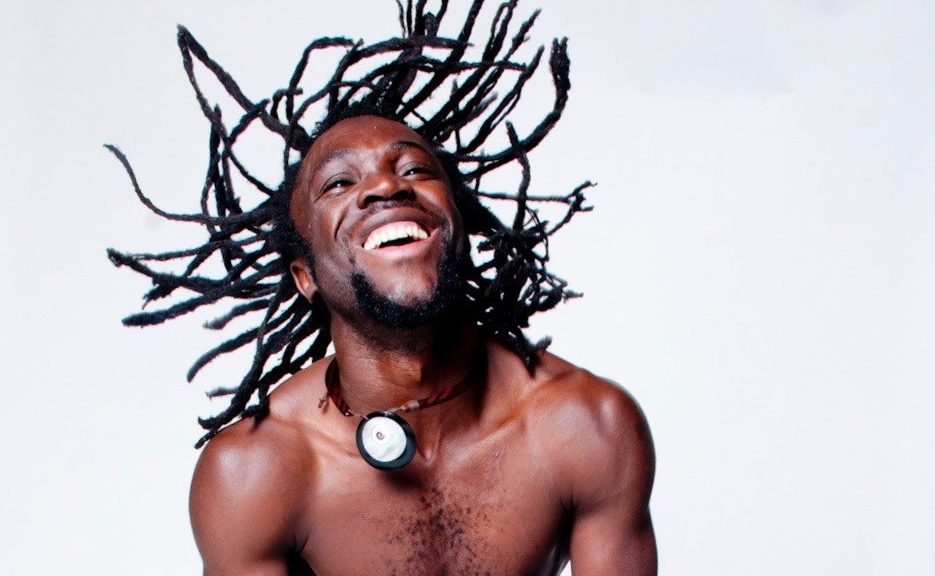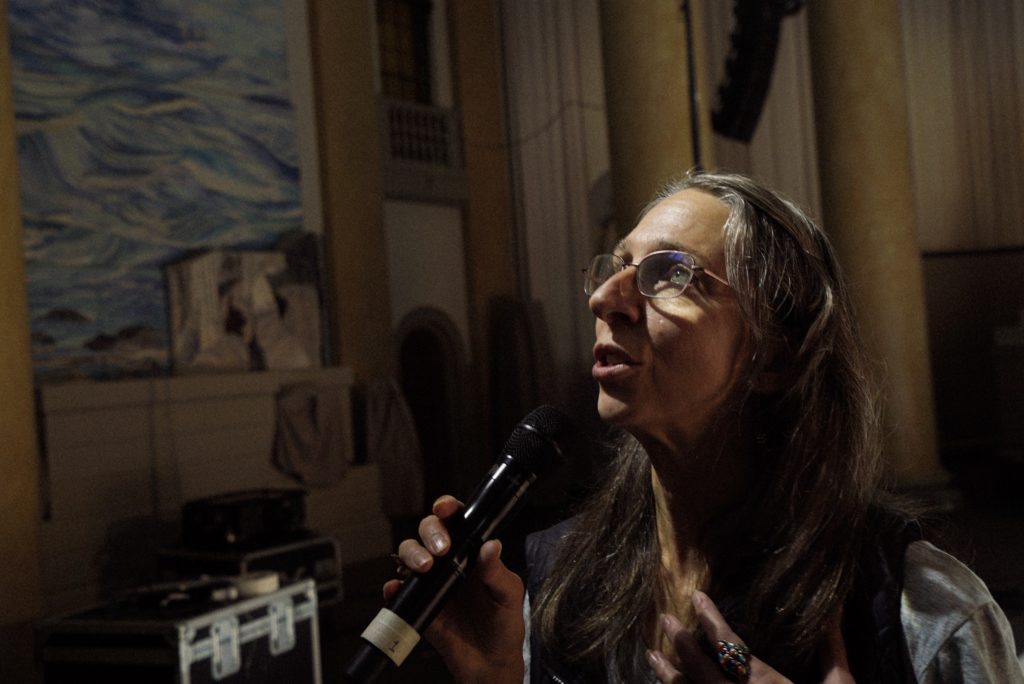
The Fresh Festival Brings a “Reckoning”
The Fresh Festival, which plays at the Joe Goode Annex in San Francisco every Friday and Saturday evening in January, proposes a series of performances that show a “bold, wild, vulnerable willingness to try something new in front of your eyes, have the power to change your mind, your day, your life,” according Kathleen Hermesdorf, the Festival curator. The Festival is celebrating its tenth anniversary around the theme of “Reckoning,” a political ambition, in which “we are . . . Facing the music. Figuring the math. Facing our natures. Facing truth and consequences,” according to Hermesdorf. But the “we” to which she refers is perhaps to people other than those in the audience, because it did not seem as if the performances required the audience to “reckon” with any misguided thinking or behavior for which spectators were responsible. The program for January 4 and 5 contained three pieces. From these works, one might assume that “freshness” implies performances that are not dance or theater or poetry slams or multimedia spectacles or performance art but something that combines all of these or attempts to be something other than any of them.
Sara Shelton Mann “designed,” rather than choreographed the first piece, 27/vortex, which began with Mann telling a childhood story: when she was six, she packed a duffel bag with the idea of leaving her Midwestern home and finding some great freedom in the world beyond her farm. One day, she saw the door open with nobody around, and she contemplating leaving with her duffel bag “taking the next step.” As Mann tells this story, a male dancer appears and performs studio exercise type movements in a corner of the performance space. Music plays. A second male dancer appears and brings a table on stage. He performs various gyrating movements on the table, while other dancers, four men and three women, perform studio exercise movements. The complicated soundtrack (managed expertly by Tim Russell) includes more voiceover stories, one male story, one by a woman speaking French, and a third by a woman speaking Spanish. Finally, Mann returns to give a speech while the dancers perform in the background. She delivers an attack on capitalism and requests or commands (of whom it is not clear) that someone “take me to the world that’s real . . . Teach me how to laugh . . .” and then voices a warning: “our civilization is being sacrificed” and people in the future will ask “us” “why you didn’t do anything when there was still time to act.” The relation of the dancers to the speakers is not clear, other than that the studio-exercise type dancing functions perhaps to signify some generic condition of “freedom” Mann was seeking as a child.

The second piece, Disorienting Front, was a solo performance by Chrysa Parkinson, a professor of dance in Stockholm. She wandered around the performance space describing the different meanings of the word “front.” She left the space but continued to discuss the word “front” as the speakers carried her microphone voice. She flushed a toilet and appeared on a balcony above the audience to deliver more meanings for “front.” Eventually she returned to the stage to explain that front is “not a place,” perhaps an identity. “Where does front go?” If the piece is dance, then the meaning of the word “dance” is even more unstable than the word “front,” although Parkinson does not claim the piece is dance. Indeed, she makes no effort to define “front” in a physical way. She does not try to use her body to define “weather front,” for example, in any way that is distinct from “front” as a deception or as a zone of conflict between contesting adversaries. The piece reminds one of graduate seminars on French deconstruction theories of the 1970s and 1980s: when you examine the definition of any word, the “meaning” of the word becomes uncertain, phantasmal, and the “meaning” of everything becomes unstable, even pointless, while communication is nothing more than the sharing of misunderstandings. In this context, the word “fresh,” too, doesn’t have much stability, either.
The last piece on the program, 350 & Million Moving Targets, was also the strongest. This was the work of Byb Chanel Bibene and Kiandanda Dance Theater, a group of eleven dancers (ten women and one man plus Bibene), all of whom were on stage for most of the piece. The theme of the piece is the flight of refugees across “waters” that often claim their lives: “Humanity is sinking with a million moving targets also called refugees and immigrants.” The multi-ethnic ensemble of dancers simulate Africans rowing across water and encountering various obstacles to freedom. A storm arises, the refugees encounter government bureaucracies that separate families or place them in camps, and at one point the refugees must wear blindfolds while navigating their trek. In one scene, the refugees perform a dance with orange scarfs. In another scene, the refugees lie down, while Bibene performs an acrobatic solo. The piece makes use of video projections that feature television news imagery of migrants and data about migration patterns. The soundtrack is varied, including some African music, but one scene is especially effective in using a loud, pulsating bass ostinato. The piece concludes with the ensemble approaching the audience carrying placards, relics, or tokens of their journey. The dancing was not especially skillful, was even rather clumsy, but the choreography was often imaginative and gave a sense of a shared trauma, hope, and deep uncertainty. The awkwardness of the dancing actually enhanced the feeling of struggle. The piece does not provide much insight into the refugee problem or offer any solutions to it. The choreography does not individualize the refugees or show them in conflict with each other or suggest any kind of internal hierarchy within the refugee class. The point of the performance is apparently to provoke empathy for people striving against great dangers to achieve the freedoms the audience already enjoys.
350 & Million Moving Targets lasts about thirty minutes. The second intermission was about forty minutes, but it took only about two minutes to set up for the final piece. Hermesdorf urged the audience to network and drink cups of wine from the tiny bar. The show was overcrowded, with some spectators standing in the balcony, but the seating for the space is small. When intermissions last as long as the performance, then a major purpose of the Fresh Festival is to create the atmosphere of a social club. The audience consists largely of people involved in the performances, friends of the performers, and persons involved in similar small performances in San Francisco. If you aren’t a member of the club, the intermissions can seem interminable. But the performances lack the conflict-driven action, theatricality, and display of physical virtuosity that attract strangers. The point of postmodern performances such as these is to create a “democratic” social environment, free of the hierarchical identities that bedevil more mainstream arts institutions. It is an environment that discourages competitiveness and ambitious concentrations of power into artists looking to move beyond whatever world they inhabit. The Fresh Festival is about affirming and sharing these values within a cloistered environment, such as the Joe Goode Annex, where social interaction between audience and performers is the primary goal and the performances may seem almost incidental.
The Fresh Festival continues at the Joe Goode Annex, 401 Alabama Street, San Francisco. Friday and Saturday, January 11 and 12: Amara Tabor-Smith, Epiphany Dance Theater, Fauxnique & VivvyAnne ForeverMORE!; Friday and Saturday January 18 and 19: NAKA Dance Theater, Claudia Lavista Proyecto al Margen [Karen De Luna + Diego Martínez Lanz]; ProyectoCASĀ [Cultural Exchange Mexico, Gizeh Muñiz + Sebastian Santamaría]; Friday and Saturday January 25 and 26: ALTERNATIVA’s 20th Anniversary Shows featuring FAKE Company and DaFuQ. Tickets: https://freshfestival.org/performances/.